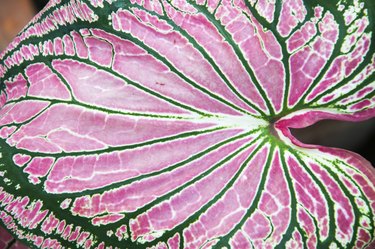
Producing colorful, arrow- to lance-shaped leaves in spring and summer, caladiums (Caladium bicolor) die back in fall to the fleshy, underground tubers. Can you grow caladiums in pots? Caladiums in containers do well as patio or deck plants. The foliage gives a long-lasting display as opposed to plants that depend on flowers for color. Green leaves are streaked, mottled and blotched with shades of white, pink and red, often with two or more colors per leaf.
These subtropical plants are native to South America and are hardy in U.S. Department of Agriculture plant hardiness zones 9 through 10. Treat caladiums as annuals in USDA zones below 9 or bring them indoors for overwintering.
Video of the Day
Video of the Day
Choose and Prepare a Container
If you're growing caladiums as patio plants, choose colorful, ornamental pots that contrast with or complement the leaf colors. If you intend to grow caladiums in containers to sink in outdoor planting beds, choose functional 6-inch-wide nursery pots. All containers should have multiple drainage holes.
Wash used containers in hot soapy water, rinse well, and then soak them in a solution of 1 part household bleach to 9 parts water for at least five minutes. Rinse well and let dry.
Select a Caladium Cultivar
Caladiums come in two different forms. Tall-growing fancy-leaved caladiums reach 12 to 30 inches tall and have heart-shaped or arrow-shaped leaves on long stems. Shorter-stemmed, lance- or strap-leaved varieties are usually less than 12 inches tall, have more leaves per tuber, and have more elongated leaves.
Thousands of caladium cultivars exist. Some widely grown varieties include 'Freida Hemple,' with deep red, green-margined leaves; 'Carolyn Wharton,' displaying pink leaves with red veins and green margins and white-leaved 'June Bride.'
Caladium Culture and Planting
In their native habitats, caladiums grow beneath forest trees. They need moist, fertile, acidic soil rich in organic material, and good drainage. For containers, use a quality potting mix that contains peat and perlite. Caladium tubers are graded for size.
Plant large tubers 12 inches apart and small tubers 8 inches apart, covering them with 2 inches of soil. Place the tubers with the lumpy side facing up. This surface contains the eyes that grow into new leaves.
Light and Water Requirements
Tender caladium leaves burn in full sunlight, so give plants partial or full shade. For brightly colored leaves, partial shade rather than full shade develops the best coloration. Keep the soil around the tubers evenly moist but not soggy while they're growing, especially during hot summer weather. Water the container whenever the surface of the potting mix becomes dry, watering until water runs out the drainage holes.
Caladium Fertilizer Needs
Regular fertilizing during the growing season helps produce a good crop of leaves and helps grow the tuber larger for a bigger plant next season. Avoid high nitrogen fertilizer, which can weaken the leaf colors. Apply 1 level teaspoon of 5-10-10 fertilizer to a 6-inch container every four to six weeks while the plants are actively growing. Water the container thoroughly right after scattering the fertilizer on the potting soil surface. Avoid letting fertilizer touch the leaves or stems.
Starting Caladiums Indoors
If you're growing caladiums indoors in containers to sink into garden beds, about four weeks before the last frost date, plant about three tubers per 6-inch pot. Keep the pots indoors or in a greenhouse in a brightly lit area at about 70 degrees Fahrenheit. Keep the soil moist. Sink the pots with emerging leaves up to their rims in the garden bed after all danger of frost is over, growing them throughout the summer.
Caladium Dormancy in the Winter
As nights cool in the fall, caladium leaves begin to turn yellow and wilt. Allow them to die back. For containers sunk in garden beds, remove them from the soil before soil temperatures go below 55 degrees F. Allow the potting mix to dry and store the containers in a bright, dry place that is warmer than 60 degrees F.
When the leaves are dry, cut them off at ground level. So that disease or pests aren't transferred to healthy plants, sterilize your pruning tools by wiping the blades off with alcohol before trimming.
For patio or deck container caladiums, move them indoors before frost occurs. Place them in a sunny location and allow the leaves to yellow, wither and die back as days shorten. Then let the potting mix dry out. Begin watering again four weeks before the last frost date.